December 13th, 2009
Andy Adams of Flak Photo and Miki Johnson of RESOLVE have joined forces in beginning a crowd-sourced dialogue about the future of photobooks. They’ve asked, “What do you think photobooks will look like in 10 years? Will they be digital or physical? Open-source or proprietary? Will they be read on a Kindle or an iPhone? And what aesthetic innovations will have transformed them?” George Slade has weighed in; so has Elizabeth Avedon, Amy Stein and Darius Himes, and Jörg Colberg wants to see more “curated photo books.” Considering the nature of this discussion (crowd-sourced) and the people involved, the answer is simple – anyway we want them to look.
The book form is not going anywhere and the photobook “publishing” industry of today is ever expanding – limited edition artist books, print-on-demand, indie publishers, self-published books, and the gamut of small to large traditional publishers. (After all, what would replace books as the backdrop for countless expert TV interviews? Okay, sarcasm aside.)
When Words Without Pictures (another crowd-sourced discussion on the “directional shifts in photography”) came out last year in book format, it was offered as either a printed book or a downloadable PDF. While I saw the benefits of getting a digital version (easily searchable), I preferred the flip-able, tangible book and made the conscious choice of buying a traditional printed and bound book. As the title suggests though, there were no photographs and this is a discussion about photobooks.
I’ll approach this topic as a collector of photography and photography books. There are different reasons to love and collect photobooks – the photographer, the body of work, the design, the aesthetics, the new-book-smell, the object itself, etc. The photobook is a creative expression in its own right. Losing the book as object is losing a unique visual expression. Having an e-book on some sort of e-reader defeats part of the purpose and the reason for collecting. Just look at a photographer’s website if you are going to look at photographs on a digital platform photobook – unless, that is, if the digital format has furthered the photobook in ways that the traditional book cannot.
The digital format does prove beneficial when talking about out-of-print books or of photography work not available on the internet. I’m thankful for Martin Parr and Gerry Badger’s The Photobook: A History Volumes I and II so I can reference books not in my personal collection without spending the entire day at the Library of Congress. I’m also thankful for Errata Editions for resurrecting classics through their Books on Books series. And I like that Google is digitizing books. Putting aside the debate over copyright issues, being able to virtually flip through a hard-to-find book in order to do research, as a reference, or to assess if I want to buy it or not is extremely useful. If the choice is a digital version or nothing – I will choose the digital document and then eventually seek out the original hard copy.
So what will photobooks look like in ten years? I see more limited edition artist books, self-published and independent ventures, more photographer collaboration, and multi-media “books.” Maybe there will be a museum for photography books (different in nature than a library) and maybe someone will have come up with book materials that aren’t so delicate – no scuffing, no paper disintegration, no cracked binding, no pages pulling away from the spine. It would solve my neurosis of wanting to own a pristine copy and be able to enjoy it at the same time.
December 11th, 2009
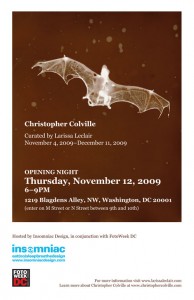
Today is the last regularly scheduled day for the FotoWeek DC exhibition Christopher Colville, but I am pleased to announce that the exhibition has been extended!! The photographs by Christopher Colville will be up through the new year and into January and can be seen by appointment only. So get in touch! contact@larissaleclair.com
Christopher Colville
curated by Larissa Leclair
in conjunction with FotoWeek DC, @Insomniac Design, Blagden Alley
In his first solo show in Washington, D.C., Christopher Colville, an Arizona-based photographer, explores the themes of time as manifested in death and memory in a selection of work curated by Larissa Leclair from his series Emanations, Iceland Trilogy, and Sonoran Project.
Christopher Colville is a photographer who pushes the boundaries of the medium. He embraces traditional and experimental processes, such as photograms, ambrotypes, and decay-generated images in his contemporary photographic work.

Emanation #1, Archival Inkjet Print from decay generated negative, 42.5"x9.5" ©Christopher Colville
In Emanations, it is the energy given off from a decaying squid that exposes the photographic paper. Colville records this journey of life, of self, of death, in a myriad of colors that conjures up cosmic matter, unknown worlds, micro and macro ecosystems. It is ephemeral and magical.
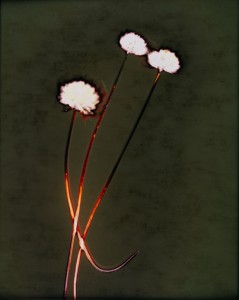
7/18/06, from Small Tragedies, unfixed P.O.P. photogram, 7"x5.6" ©Christopher Colville
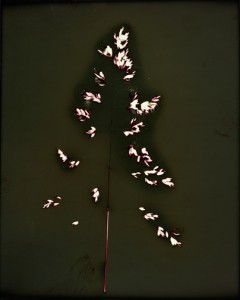
7/19/06, from Small Tragedies, unfixed P.O.P photogram, 7"x5.6" ©Christopher Colville
“Iceland Trilogy” is an interconnected body of work of ritual and connection to the landscape. Two series within “Iceland Trilogy,” Cairns and Small Tragedies, are intimately tied together in terms of the artist’s ritual of creating one photograph each day in the Icelandic landscape of his ancestors. Cairns themselves are stones used to mark pathways, as well as markers placed as memorials to the dead. Colville reflects on his own intersection with the path of others – now and of the past.
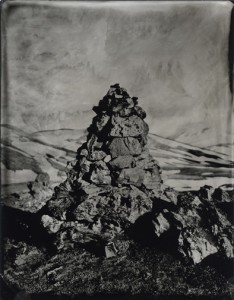
7/23/06, from Cairns, Wet-Plate Ambrotype, 7"x5.6" ©Christopher Colville
Sonoran Project is Colville’s latest body of work. Life in the Arizona desert is both miraculous and tenuous. In the vast landscape there are traces of life in all stages. His photograms capture a mythical spirituality of the natural world.
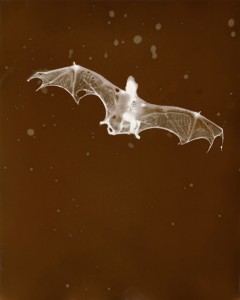
Bat, from Sonoran Project, 18.4" x 23", P.O.P. photogram ©Christopher Colville
This selection of work, seen together for FotoWeek DC, explores the cycle of life, the passage of time, history, and the landscape that embodies us all.
Christopher Colville is a photographer and teacher at Arizona State University. He has been awarded a 2008 Artist Project Grant from the Arizona Commission on the Arts and a 2008 Public Art Commission from the Phoenix Commission on the Arts as well as an American Scandinavian Foundation Fellowship in 2006 to photograph in Iceland. Colville was also awarded the Van Daren Coke/Beaumont Newhall Fellowship in 2003. He holds an MFA in Photography from the University of New Mexico and a BFA in Anthropology and Photography from Washington University in St. Louis, Missouri.
Larissa Leclair is an independent writer and curator in the DC area.
Insomniac Design is a web design and development firm in DC.
FotoWeek DC is a 501(c)3 nonprofit organization founded in 2008 whose mission is to celebrate the power of photography and to unite and strengthen the Washington DC photography community.
All photographs are available for purchase. Prices vary depending on edition number.
December 10th, 2009

© Scurlock Studio
The Scurlock Studio and Black Washington: Picturing the Promise
National Museum of African American History and Culture Gallery, National Museum of American History
Washington, DC
January 30, 2009–February 28, 2010
Washington D.C. can be seen as the nexus for national and international politics, art, and culture, but it also has its own local history often overshadowed by this larger stage. On view at the National Museum of American History is the outstanding exhibition “the Scurlock Studio and Black Washington: Picturing the Promise” that presents a piece of African American history in the nation’s capitol as seen through the photographic lens of Addison Scurlock and his two sons, George and Robert. The Scurlock Studio, throughout most of the 20th century, captured a vibrant and thriving African American community on U Street and its surrounding neighborhoods and created portraits that represented a proud and positive self-image, described in one caption as “urban, urbane, and modern.” The exhibition features over 100 mostly black-and-white photographs by the Scurlock Studio, along with memorabilia from their business, the longest-running black business in Washington – started in 1911 and closed in 1994. There are photographs of families, weddings, meetings, graduations, and businesses; portraits of the working class, middle class, and elite; photographs capturing life at Howard University; and images of W.E.B. Du Bois, Booker T. Washington, Muhammad Ali, and Duke Ellington.
To quote from the exhibition, co-curated by Michelle Delaney, Associate Curator of the Photographic History Collection at the National Museum of American History, and Paul Gardullo of the National Museum of African American History and Culture, “[t]he Scurlocks depicted the complex world of African Americans in Washington, D.C., a city whose black middle class refused to be defined or held captive by racial segregation and discrimination.” Looking at the photographs, it is possible to forget that during the time the photographs were taken, segregation was in effect and imposed a racial divide in Washington, D.C. and elsewhere across the United States. The only hints at this history are the photographs of a man protesting outside People’s Drugstore to boycott businesses that did not hire black workers in black neighborhoods, the concert of Marian Anderson on the steps of the Lincoln Memorial to a mixed crowd of over 75,000 instead of at Constitution Hall because of the color of her skin, the March on Washington, and in the sequence of images taken of the 1968 riots – photographs of fires and of U.S. Army Jeeps with armed soldiers patrolling U Street – just outside their studio window.
When the new National Museum of African American History and Culture opens along the national Mall in 2015, as the 19th Smithsonian Institution museum, the Scurlock Studio photographs should become a permanent exhibit there. As Arkansas has Disfarmer and Mali has Seydou Keïta and Malick Sidibé, Washington, D.C. has the Scurlocks, a photographic family team that created a lasting historical record of everyday African American life in the nation’s capitol with exquisite technique and sensibility.
Explore the Scurlock Studio Collection at the National Museum of American History online. Also available is the exhibition catalog, The Scurlock Studio and Black Washington: Picturing the Promise, produced by Smithsonian Books.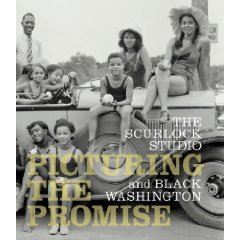
Originally published in ArtVoices Magazine, November 2009.
December 3rd, 2009

RADIUS BOOKS hosts it’s 3rd annual anniversary party and all are invited!
What Radius Books annual party and holiday book sale: all titles 30% off!
When Friday, December 4, 2009 5–8 pm
Where 519 Cerrillos (in the old Luna building, across from Hotel Santa Fe), Santa Fe, NM
This event coincides with the release of three new Radius books: a major monograph on Venice-based painter Ed Moses who has been a major influence on the southern California art scene for over 50 years, Bingham Mine / Garfield Stack, by Bay Area-based photographer Michael Light, and the photographic duet Violet Isle, by Alex Webb and Rebecca Norris Webb.
Meet the Artists: Joan Watts, Judy Tuwaletstiwa, Johnnie Winona Ross, Michael Light, and John McCracken will all be on hand to sign copies of their books.
For more information contact us at 505 983 4068 or info@radiusbooks.org
If you can’t make it to Santa Fe tomorrow night, Radius is also offering 30% off on all online orders. Click here to get the super secret discount code and also sign up for the Radius Books newsletter.
Start your holiday shopping. Transfigurations by Michael Lundgren is on my wish list!








